 Sign the Resolution
Sign the Resolution Contents | Feedback | Search
DRCNet Home | Join DRCNet
DRCNet Library | Schaffer Library | Hemp/Marijuana
Medical Information
 Sign the Resolution
Sign the Resolution
Contents | Feedback | Search
DRCNet Home | Join DRCNet
DRCNet Library | Schaffer
Library | Hemp/Marijuana
Medical Information
Page 377
AMERICAN REVIEW OF RESPIRATORY DISEASE, VOLUME 112, 1975
Effects of Smoked Marijuana in
Experimentally Induced Asthma1, 2
DONALD P. TASHKIN, BERTRAND J. SHAPIRO, Y. ENOCH LEE,
and CHARLES E. HARPER
SUMMARY
After experimental induction of acute bronchospasm in 8 subjects with clinically stable bronchial asthma, effects of 500 mg of smoked marijuana (2.0 per cent Delta 9-tetrahydrodrocannabinol) on specific airway conductance and thoracic gas volume were compared with those of 500 mg of smoked placebo marijuana (0.0 per cent Delta 9-tetrahydrocannabinol), 0.25 ml of aerosolized saline, and 0.25 ml of aerosolized isoproterenol (1,250 ug). Bronchospasm was induced on 4 separate occasions, by inhalation of methacholine and, on four other occasions, by exercise on a bicycle ergometer or treadmill. Methacholine and exercise caused average decreases in specific airway conductance of 40 to 55 per cent and 30 to 39 per cent, respectively, and average increases in thoracic gas volume of 35 to 43 per cent and 25 to 35 per cent, respectively. After methacholine-induced bronchospasm, placebo marijuana and saline inhalation produced minimal changes in speci! fic airway conductance and thoracic gas volume, whereas 2.0 per cent marijuana and isoproterenol each caused a prompt correction of the bronchospasm and associated hyperinflation. After exercise-induced bronchospasm, placebo marijuana and saline were followed by gradual recovery during 30 to 60 min, whereas 2.0 per cent marijuana and isoproterenol caused an immediate reversal of exercise-induced asthma and hyperinflation.
Introduction
Recent studies have demonstrated significant, acute bronchodilatation in healthy young men after both smoked marijuana (1, 2) and oral Delta 9-tetrahydrocannabinol (Delta 9-THC), the principal psychoactive ingredient in marijuana (2). More recently, the smoking of marijuana and ingestion of Delta 9-THC by subjects with chronic, clinically stable, bronchial asthma of minimal to moderate severity has been shown to produce airway dilatation of a magnitude similar to that previously noted in healthy subjects (3). Although these findings appear to support the benefit ascribed to the use of cannabis in the last century for the treatment of bronchial asthma (4), they do not provide any direct evidence for a bronchodilator effect of marijuana during an acute asthmatic attack. In the present study, the effects of smoked marijuana on bronchomotor tone were evaluated in asthmatic subjects after acute bronchospasm was induced either by inhalation of methacholine or ! by exercise.
Materials and Methods
Eight patients with bronchial asthma characterized by typical attacks of wheezing, breathlessness, and cough at least partially relieved by bronchodilator medication and without other significant medical illness were selected for study. All subjects were clinically stable at the time of the study. Three subjects had participated in previous studies to evaluate the acute bronchial effects of smoked marijuana and oral Delta 9-THC in stable asthma (3). Five subjects had smoked marijuana previously. Of these 5 subjects, one had smoked marijuana only in connection with the previous study (3), 3 had smoked infrequently (less than 1 joint per month), and one had smoked regularly, but mildly (I joint per week).
___________________________
(Received in original form February 20, 1975 and in revised form June 19, 1975 )
1 From the Division of Pulmonary Disease, Department of Medicine, UCLA School of Medicine, Los Angeles, Calif. 90024.
2 Supported by U. S. Public Health Service Grant no. HSM 42-71-89.
___________________________
Page 378
AMERICAN REVIEW OF RESPIRATORY DISEASE
TASHKIN, SHAPIRO, LEE, AND HARPER
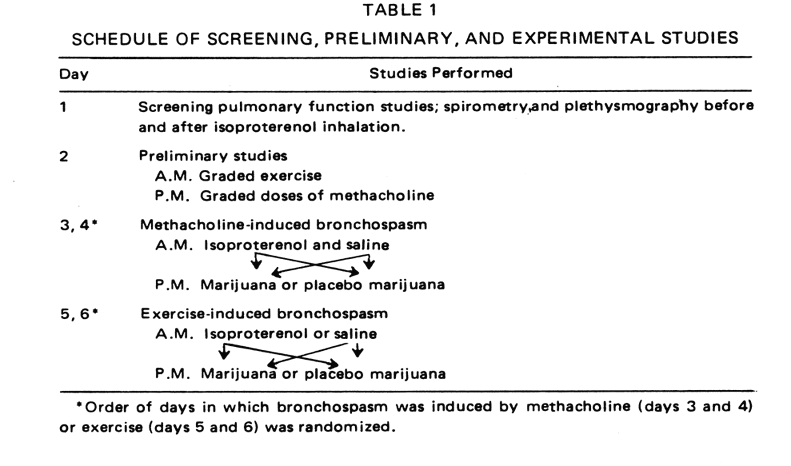
No subject had used marijuana within 7 days of the study. No subject was a tobacco cigarette smoker. The schedule of screening, preliminary, and experimental studies is indicated in table 1. Days on which studies were performed were generally separated by 1 week or less. All oral bronchodilator drugs were withheld for at least 8 hours; inhaled bronchodilator drugs were withheld for at least 4 hours before the beginning of each morning or afternoon study session. Screening studies were performed on day 1 and consisted of spirometry using a 13.5-liter, water-seal spirometer (Warren E. Collins, Inc.), and measurement of single-breath diffusing capacity for CO (DLco) (5), airway resistance (Raw), and thoracic gas volume (Vtg) using a 900-liter, variable-pressure, body plethysmograph (6, 7). The Vtg and Raw were measured at or near the volume of resting end -expiration. The average slope of the inspiratory and expiratory pressure-flow loops at flows of + 0! .5 liter per sec was used in the calculation of Raw. Plethysmographic measurements were made in quintuplicate, and the results were averaged. Plethysmographic and spirometric measurements were performed before and 5 to 10 min after inhalation of 1,250 mg of isoproterenol hydrochloride as previously described (3) to establish the presence of reversible bronchospasm.
Preliminary studies were performed in the morning (9 A.M.) and afternoon (1:30 P.M.) of day 2 to determine the type, duration, and severity of exercise and the dose of methacholine required to produce the required degree of bronchospasm. (see below). During the morning session, two sets of control measurements of Raw and Vtg were obtained 15 min apart, after which bronchospasm was induced by exercise either oil a bicycle ergometer (3 subjects) or on a treadmill (4 subjects). Treadmill exercise was used if a subject felt uncomfortable riding a bicycle or if previous exhaustive exercise on a bicycle ergometer failed to produce the requisite degree of bronchoconstriction. Each subject performed stead), exercise for 6 to 10 min using incremental work loads of 200 to 650 kilopond-m (bicycle ergometer) or 1 to 3.5 mph at a 0 to 10 per cent grade (treadmill) until specific airway conductance (SGaw = 1Raw/Vtg) determined within 10 min of completion of the exercise d! ecreased by at least 20 per cent from the mean of that subject's control values. When this degree of bronchoconstriction was not achieved, exercise was repeated at the next higher work load after a rest of at least 15 min and after plethysmographic measurements had returned to initial control values. In one subject (JB), bronchospasm could not be provoked despite exhaustive treadmill exercise. During the afternoon session, after plethysmographic measurements of Raw and Vtg had returned to values similar to those obtained during the control period of the morning session, each subject inhaled graded doses of methacholine (62.5 to 625 ug in 0.25 to 0.5 ml of saline) until SGaw determined within 5 min of methacholine inhalation decreased by at least 25 per cent from that subject's control value. The methacholine solution, were nebulized via a DeVilbiss nebulizer connected to a positive- pressure breathing device powered by compressed air. Subjects inhaled the aerosol using ! slow, deep inspirations followed by several seconds of end-expiratory breath-holding. When the requisite degree of bronchospasm did not develop within 5 min after one dose of methacholine, the next higher dose was not administered until at least 15 min after the previous dose and after SGaw had returned to initial values.
In the morning and afternoon of days 3 and 4 (a total of 4 experimental sessions), 2 sets of control measurements of Raw and Vtg were obtained. Bronchospasm was then induced in each subject by inhalation of the same dose of methacholine that
Page 379
EFFECTS OF MARIJUANA IN ASTHMA
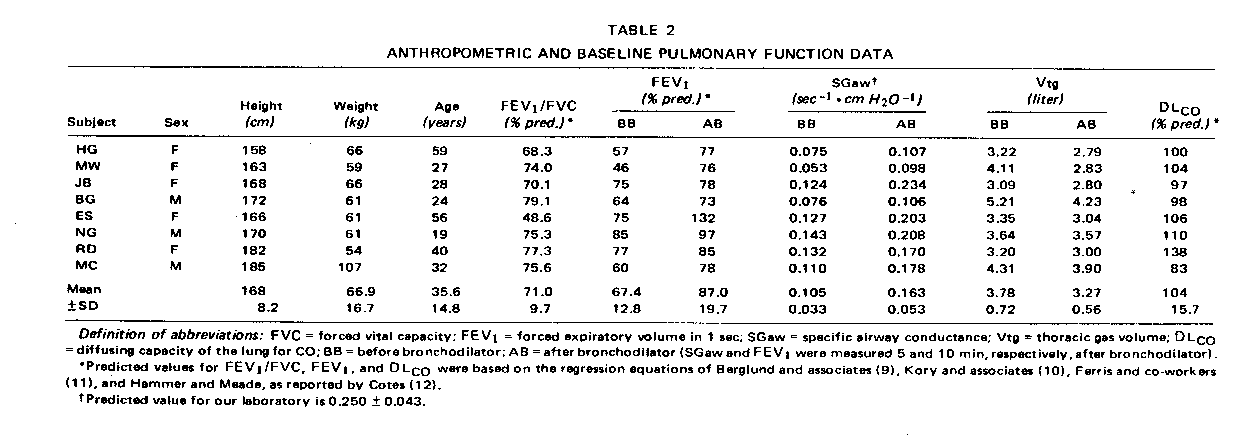
had been shown in the preliminary studies to reduce SGaw in that subject by at least 25 per cent. During the morning sessions, approximately 8 to 9 min after induction of bronchospasm, subjects inhaled 0.25 ml of either saline or 0.5 per cent isoproterenol (Iso) in a randomly ordered, single blind fashion using the same nebulization and inhalation techniques that had been used to administer the methacholine solution. Serial plethysmographic measurements were performed within 1 to 2 min ("zero" time), and at 5, 10, 15, 30, and 60 min after saline or Iso inhalation. During the afternoon sessions, experimental bronchospasm was induced only after plethysmographic measurements had returned to the baseline values recorded at the beginning of the morning session of the same day. Immediately after the development of bronchospasm, subjects smoked a joint containing 500 mg of marijuana assayed at either 2.0 per cent Delta 9-THC or 0.0 per cent Delta 9-THC (placebo) ac! cording to a randomly ordered, single blind protocol joints were smoked during a 10-min period using a standard deep-inhalation technique (2). Marijuana. and placebo marijuana preparations were obtained from the National Institute on Drug Abuse, under whose direction extraction, assay, and blending procedures were performed. Immediately after completion of smoking, serial plethysmographic measurements were repeated at the same intervals described previously.
In the morning and afternoon of days 5 and 6 (4 experimental sessions), after control measurements were made, bronchospasm was induced in each subject by the type, duration, and degree of exercise that had been demonstrated during preliminary studies to reduce SGaw in that subject by at least 20 per cent. Afternoon exercise was begun only after measurements had returned to the control values determined during the same morning. Using a randomly ordered, single blind protocol, in morning sessions, subjects inhaled Iso or saline 8 to 9 min after the development of bronchospasm, and in afternoon sessions, subjects smoked 2.0 per cent marijuana or placebo during a period of 10 min immediately after the induction of bronchospasm. Serial measurements of Raw and Vtg were performed at the same intervals after inhalation or smoking of the test preparations, as indicated for the methacholine experiments.
The order of the experiments in which bronchospasm was induced by either methacholine inhalation or exercise was randomized among the subject population.
Calculations. The SGaw was calculated from each set of measurements of Raw and Vtg to correct for changes in Raw secondary to changes in lung volume (8). For each subject at each time interval during each experimental protocol, per cent changes in SGaw and Vtg were calculated from the average of the 2 pre-methacholine or pre-exercise control
Page 380
AMERICAN REVIEW OF RESPIRATORY DISEASE
TASHKIN, SHAPIRO, LEE, AND HARPER
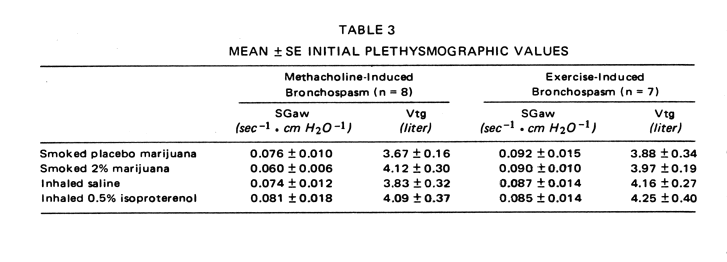
values. At each time interval for each type of experiment, the individual per cent changes in SGaw and Vtg were averaged for all subjects, thereby minimizing the factor of intersubject variability of control values. The significance of the average per cent changes in SGaw and Vtg from initial control values, of the per cent changes that followed marijuana, compared with placebo or saline, and that followed isoproterenol, compared with saline or marijuana, was determined using "Student's" t test (paired observations). In addition, the average individual differences in control values among the various types of experiments were tested for significance using the t test (paired observations) to ascertain whether all experiments were performed under comparable conditions.
Results
Physical characteristics of each subject and the results of baseline pulmonary function studies are given in table 2. Three men and 5 women from 19 to 59 years of age were studied. The ratio of 1-sec forced expiratory volume (FEV1 ) to forced vital capacity ranged between 49 and 79 per cent of the predicted value, indicating the presence of minimal to moderately severe airway obstruction. Inhalation of Iso resulted in mild to moderate increases in FEV1 and SGaw, indicating the presence of reversible bronchospasm. The DLco was normal or greater than normal, consistent with bronchial asthma (13).
The mean initial control values of SGaw and Vtg during each experimental session before induction of bronchospasm with methacholine or exercise are shown in table 3. The average individual differences in control values for each measured variable, comparing any one session with any other, were not significantly different from zero.
The mean per cent changes in SGaw and Vtg after smoked marijuana or placebo, or inhaled Iso or saline after methacholine-induced bronchospasm are shown in figures 1 and 2. Methacholine inhalation promptly caused significant bronchoconstriction, with average decreases in SGaw of 40 to 55 per cent, and significant hyperinflation, with mean increases in Vtg of 35 to 43 per cent. After subsequent placebo marijuana smoking or saline inhalation, SGaw increased only modestly, remaining significantly less than initial control values for 30 to 60 min, and Vtg decreased only gradually, remaining significantly increased for 15 min. On the other hand, 2 per cent marijuana and Iso each resulted in a prompt return of SGaw and Vtg to control values, which were significantly different from values after placebo and saline. Although the mean values for SGaw after Iso were greater than both initial control values and those after smoked marijuana, these differences were not significant.
The average per cent changes in SGaw and Vtg that followed each test preparation after exercise-induced bronchospasm are shown in figures 3 and 4. Exercise resulted in average decreases in SGaw of 30 to 39 per cent and average increases in Vtg of 25 to 35 per cent. There was a gradual return to control values during 30 to 60 min after placebo and saline. After marijuana, on the other hand, SGaw and Vtg returned promptly to pre-exercise values, which were significantly different from values after placebo and saline for 15 to 60 min. The Iso caused a prompt return of Vtg to baseline values and an immediate increase in SGaw to values that significantly exceeded initial control values and remained significantly greater than values after saline and marijuana for as long as 60 min.
The 4 subjects who had previously used cannabis experienced emotional changes after smoking marijuana that were generally pleasant, whereas no "high" developed after placebo marijuana. Because these subjects were able to distinguish between real and placebo marijuana, these experiments were not truly blind. The 4 subjects with essentially no previous cannabis experience either admitted to no central nervous
Page 381
EFFECTS OF MARIJUANA IN ASTHMA
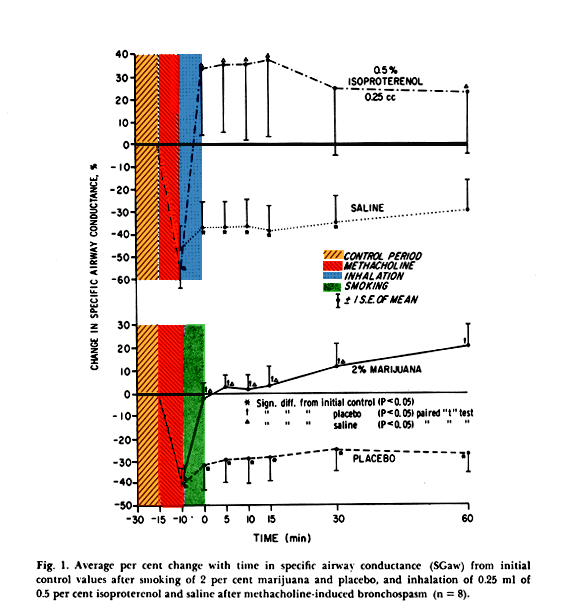
system changes or experienced mild somnolence or light-headedness after marijuana.
Discussion
The 40 to 50 per cent decrease in SGaw after inhalation of < 625 ug of methacholine noted in our subjects is consistent with the known bronchial hyper-reactivity of asthmatic subjects to muscarinic stimulation (14). In our laboratory, normal subjects require more than 5 times these doses of methacholine to develop a comparable degree of bronchoconstriction. The associated increase in Vtg observed in our asthmatic subjects was probably related to the increase in expiratory flow resistance.
There was a relatively small and nonsignificant (P > 0.05) average individual difference in the magnitude of the methacholine-induced decrease in SGaw when any one of the 4 experimental sessions was compared with any other, and a very small difference when the marijuana and placebo marijuana sessions were compared with each other (1.4 + 4.8 per cent SE). These findings indicate a reasonable degree of reproducibility of airway constriction after inhalation of the same dose of methacholine by individual subjects from one session to the next, thereby permitting a reliable comparison of the effects of marijuana, placebo, Iso, and saline on methacholine-induced bronchospasm.
Comparison of placebo marijuana smoking and saline inhalation showed negligible differences in the magnitude or duration of methacholine-induced bronchoconstriction (figure 1)
Page 382
AMERICAN REVIEW OF RESPIRATORY DISEASE
TASHKIN, SHAPIRO, LEE, AND HARPER
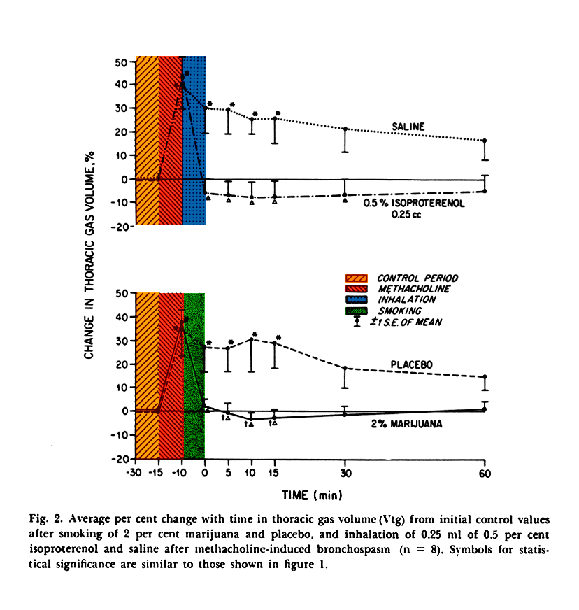
and hyperinflation (figure 2) after these two preparations. This suggests that any bronchial irritant effect of marijuana smoke was not sufficient to aggravate or perpetuate existing acute bronchospasm to an extent greater than that which might result from an irritant effect of inhaled saline. Comparison of the magnitude and time course of changes in SGaw and Vtg immediately after marijuana smoking to those after placebo marijuana and saline indicate that inhaled Delta 9-THC causes a prompt, complete, and sustained reversal of methacholine-induced bronchospasm and correction of the associated hyperinflation. These effects were not significantly different from those observed after Iso, although there was a tendency toward a greater degree of bronchodilatation after the latter.
The 30 to 39 per cent average decrease in SGaw and 25 to 35 per cent average increase in Vtg after mild to heavy exercise for 6 to 10 min in 7 of the 8 asthmatic subjects tested are consistent with previous reports of bronchospasm (15) and hyperinflation (16) after exercise. The average individual difference in exercise-related decrease in SGaw when any of the 4 study periods was compared with any other was small and nonsignificant (P > 0-2), so that the effects of smoked and inhaled test preparations on exercise-induced bronchospasm. could be validly compared.
The appropriateness of comparing effects of various drugs on bronchospasm provoked by exercise twice on the same day might be questioned, because McNeill and associates (17) found partial to complete loss of exercise-induced bronchoconstriction in 3 of 4 asthmatic subjects after repeated periods of exercise throughout one day. In our subjects, however, there were no consistent differences between the per cent decrease in SGaw after exercise during afternoon sessions and that observed in the same subjects during morning sessions. The mean + SE morning-to-afternoon
Page 383
EFFECTS OF MARIJUANA IN ASTHMA
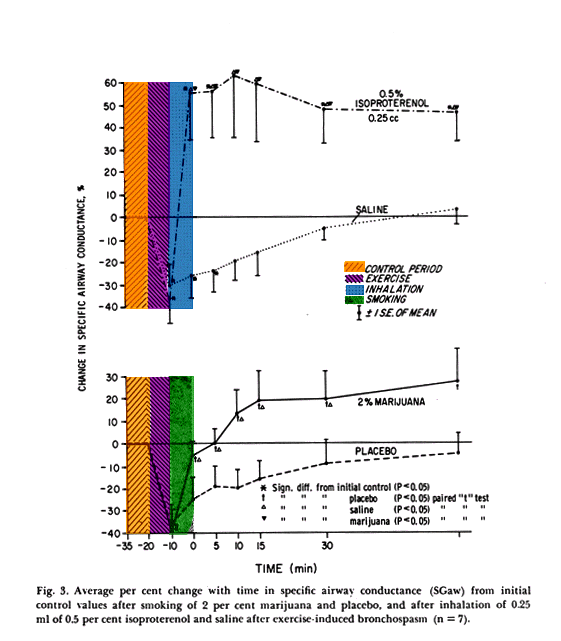
individual difference was -1.7 + 3.1 per cent (P > 0.5). Our findings are more in agreement with those of Godfrey and co-workers (18) and Silverman and Anderson (19). They showed a reproducible magnitude of postexercise bronchospasm in individual asthmatic children after a similar type and severity of exercise when repeat tests were performed either on separate days within 1 week or 2 hours apart within the same day. These investigators found more variability after bicycle ergometer than treadmill exercise.
The occurrence of the most marked changes in SGaw and Vtg during the first 10 min after induction of bronchospasm, with a gradual return to control values during 30 to 60 min after placebo or saline is characteristic of the time course of exercise-induced asthma (15, 16). The prompt return of SGaw and Vtg to pre-exercise values after smoked marijuana contrasts with the delayed recovery that followed placebo and saline, indicating the efficacy of inhaled Delta 9-THC in the correction of exercise-induced asthma. Comparison of the response to 1,250 ug of Iso with that to 2 per cent marijuana (10 mg of Delta 9-THC), however, revealed that the former caused a significantly greater degree of bronchodilatation in the doses used.
The effects of smoked marijuana on acute, experimentally induced bronchoconstriction and hyperinflation noted in the present study extend our previous observations of significant bronchodilatation and reduction in hyperinflation in resting patients with stable bronchial asthma (3).
Page 384
AMERICAN REVIEW OF RESPIRATORY DISEASE
TASHKIN, SHAPIRO, LEE, AND HARPER
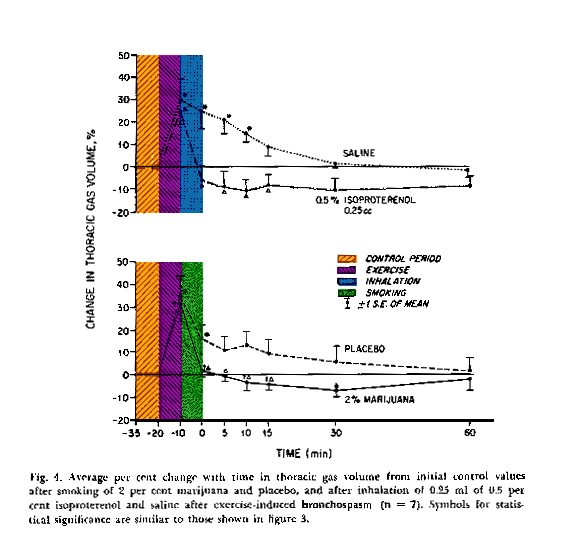
Although suggestion and other psychological factors probably play an important role in the response of asthmatic patients to inhalants (20), the lack of response to Delta 9-THC-extracted marijuana in the present study suggests that a placebo effect was not responsible for the reversal of experimentally induced asthma observed to follow smoking of natural. marijuana. Moreover, it is unlikely that pleasant emotional sensations after marijuana contributed significantly to the bronchodilatation. Although the 4 subjects with no or negligible prior cannabis experience did not admit to a feeling of tranquility or euphoria after smoking marijuana, they did demonstrate a degree of correction of experimentally induced bronchospasm comparable to that observed in the subjects who had used cannabis previously. Although the mechanism of Delta 9-THC-induced bronchodilatation has not been completely determined, previous studies have demonstrated that this effect is not mediated by B! -adrenergic stimulation or inhibition of muscarinic receptors (21). A vagolytic mechanism proximal to the muscarinic receptor site is suggested by correlative studies involving the dog salivary gland (22) and guinea pig ileum (23).
Our present findings and those previously reported (1-3) demonstrated acute airway dilatation after smoked marijuana. In contrast, mild, but significant, reductions in forced expiratory flows and SGaw after chronic, heavy marijuana smoking were recently reported (24), suggesting airway obstruction secondary to a chronic irritant effect of the smoke. An acute, deleterious effect of the gas phase of marijuana smoke on alveolar macrophages has also been demonstrated in vitro (25). Consequently, smoking would not appear to be an appropriate long-term method for administration of bronchodilator cannabinoid compounds for potential therapeutic purposes. Although ingestion of Delta 9-THC in a sesame oil vehicle has produced bronchodilatation in asthmatic patients (3), less dilatation was noted than that after smaller doses of Delta 9-THC delivered by smoking (3). In preliminary studies in our laboratory, aerosolization of an ethanol solution
Page 385
EFFECTS OF MARIJUANA IN ASTHMA
of Delta 9-THC using a Freon® propellant resulted in mean peak increase in SGaw of 88 per cent in 4 normal subjects, but unwanted psychological effects were not circumvented. Regardless of its route of administration, Delta 9-THC does not appear to be a suitable bronchodilator for therapeutic use because of its systemic psychotropic and possible undesirable endocrine, immunologic, and cytogenetic effects (26). Related cannabinoid compounds, however, such as cannabinol and cannabidiol, do not produce the central nervous system effects or tachycardia characteristic of cannabis (27), but appear to share another and potentially useful property with D-THC. reduction of intraocular pressure (28). These compounds should be further investigated for possible bronchodilator activity and therapeutic utility.
Acknowledgment
The writers are indebted to Dr. Daniel H. Simmons for help in review of the manuscript.
References
1. Vachon, L., FitzGerald, M. X., Solliday, N. H., Gould, 1. A., and Gaensler, E. A.: Single-dose effect of marijuana smoke: Bronchial dynamics and respiratory-center sensitivity in normal subjects, N Engl J Med, 1973, 288, 985.
2. Tashkin, D. P., Shapiro, B. J., and Frank, I. M.: Acute pulmonary physiological effects of smoked marijuana Delta 9-tetrahydrocannabinol in healthy young men, N Engl J Med, 1973, 289, 336.
3. Tashkin, D. P., Shapiro, B. J., and Frank, 1. M.: Acute effects of smoked marijuana and oral Delta 9-tetrahydrocannabinol on specific airway conductance in asthmatic subjects, Am Rev Respir Dis, 1974, 109, 420.
4. Grinspoon, L.: Marijuana, Sci Am, 1969, 221, 17.
5. Ogilvie, C. M., Forster, R. E., Blakemore, W. S., and Morton, J. W.: A standardized breath holding technique for the clinical measurement of the diffusing capacity of the lung for carbon monoxide, J Clin Invest, 1957, 36, 1.
6. DuBois, A. B., Botelho, S. Y., and Comroe, J. H., Jr.: A new method for measuring airway resistance in man using a body plethysmograph. Values in normal subjects and in patients with respiratory disease, J Clin Invest, 1956, 35, 327.
7. DuBois, A. B., Botelho, S. Y., Bedell, G. N., Marshall, R., and Comroe, J. H., Jr.: A rapid plethysmographic method for measuring thoracic gas volume, J Clin Invest, 1956, 35, 322.
8. Briscoe, W. A., and DuBois, A. B.: Relation between airway resistance, airway conductance and lung volume in subjects of different age and body size, J Clin Invest, 1958, 37, 1279.
9. Berglund, E., Birath, G., Bjure, J., Grimby, G. Kjellmer, I., and Söderhohm, B.: Spirometric studies in normal subjects. 1. Forced expirograms in subjects between 7 and 70 years of age Acta Med Scand, 1963, 173, 185.
10. Kory, R. C., Callahan, R., Boren, H. G., and Svner, J. C.: The Veterans Administration-Army cooperative study of pulmonary function. 1. Clinical spirometry in normal men, Am J Med, 1961, 30, 243.
11. Ferris, B. G., Jr., Anderson, D. 0., and Zick-mantel, R.: Prediction values for screening tests of pulmonary function, Am Rev Respir Dis, 1965, 91, 252.
12. Cotes, J. E.: Lung Function, F. A. Davis Company, Philadelphia, 1965.
13. Meisner, P., and Hugh-Jones, P.: Pulmonary function in bronchial asthma, Br Med J, 1968 1, 470.
14. Felarca, A., and Itkin, I. H.: Studies with the quantitative-inhalation challenge technique. 1. Curve of dose response to acetyl-beta-methylcholine in patients with asthma of known and unknown origin, hay fever subjects, and nonatopic volunteers, J Allergy, 1966, 37, 223.
15. Beall, G. N., Heiner, D. C., Tashkin, D. P., and Whipp, B. J.: Asthma: New ideas about an old disease, Ann Intern Med, 1973, 78, 405.
16. Cropp, G. J. A.: Acute, exercise- induced pulmonary hyperinflation in asthmatic children, Clin Res, 1974, 22, 244A.
17. McNeill, R. S., Nairn, J. R., Millar, J. S., and Ingram, C. G.: Exercise-induced asthma, Q J Med, 1966, 35, 55.
18. Godfrey, S., Silverman, M., and Anderson, S. D.: Problems of interpreting exercise-induced asthma, J Allergy Clin Immunol, 1973, 52, 199.
19. Silverman, M., and Anderson, S. D.: Standardization of exercise tests in asthmatic children, Arch Dis Child, 1972, 47, 882.
20. Luparello, T., Lyons, H. A., Bleecker, E. R., and McFadden, E. R., Jr.: Influences of suggestion on airway reactivity in asthmatic subjects, Psychosom Med, 1968, 30, 819.
21. Shapiro, B. J., Tashkin, D. P., and Frank, 1. M.: Mechanism of increased specific airway conductance with marijuana smoking in healthy young men, Ann Intern Med, 1973, 78, 832.
22. Cavero, I., Buckley, J. P., and Jandhyala, B. S.: Parasympatholytic activity of (-)-Delta 9-transtetrahydrocannabinol in mongrel dogs, Eur J Pharmacol, 1972, 19, 301.
23. Gill, E. W., Paton, W. D. M., and Pertwee, R. G.: Preliminary experiments on the chemistry and pharmacology of cannabis, Nature, 1970, 228, 134.
24. Tashkin, D. P., Shapiro, B. J., Lee, Y. E., and Harper, C. E.: Chronic effects of heavy marijuana
Page 386
AMERICAN REVIEW OF RESPIRATORY DISEASE
TASHKIN, SHAPIRO, LEE, AND HARPER
smoking on pulmonary function in healthy young males, Presented at the International Conference on the Pharmacology of Cannabis, Savannah, Ga., December, 1974.
25. Cutting, M., Watson, A., Goodenough, G., Simmons, G., Laguarda, R., and Huber, G.: The effect of exposure to rnarijuana. smoke on the bactericidal activity of pulmonary alveolar macrophages, Clin Res, 1974, 21, 501A.
26. United States Congress: Marijuana and Health: Fourth Annual Report from the Secretary of the Department of Health, Education and Welfare, Washington, D. C., U. S. Government Printing Office, 1974.
27. Hollister, J. E.: Cannabidiol and cannabinol in man, Experientia, 1973, 29, 825.
28. Perez-Reyes, M.: The clinical pharmacology of intravenously administered cannabinoids: Psychological, cardiovascular and intra-ocular pressure effects, Presented at the International Conference on the Pharmacology of Cannabis, Savannah, Ga., December, 1974.